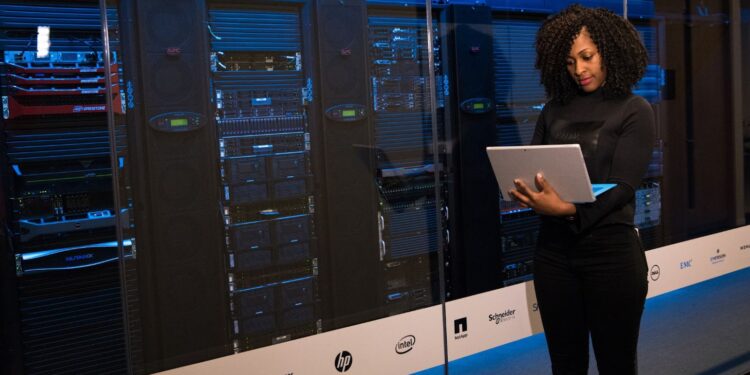You’ve probably noticed this abbreviation when reading articles on system administration topics. The term “PDUs” stands for Power Distribution Units. As it is clear from the name, the PDU is an appliance that is responsible for allocating incoming energy between IT equipment, telecommunications hardware, and other network system components. Thus, the device does not condition or generate any electric power; it just delivers alternative current generated by a utility power source or a generator.
The Importance of Rack PDUs
Telecom systems consume energy and cannot perform smoothly without a continuous feeding of power. Thus, PDUs are crucial for feeding network systems and ensuring stable hardware operation. A server rack power strip comes as an indispensable element of server system arrangement. In most cases, multiple PDUs are used to deliver current to system components.
Modern facilities entrust multiple operations to telecom systems. They are responsible for datum storage, calculations, and info processing. Thus, advanced hardware models are produced to boost efficiency and reduce costs. To meet the demand for increased computing capabilities, system administrators install updated hardware that requires more powerful feeding and energy supply. Thus, the issue of selecting proper PDUs is topical.
Types of PDUs for Telecom Systems
When dealing with rack PDUs (rPDU), technicians should know the classification of devices to pick a suitable model. Devices fall into the next types:
- Basic products. These are entry-level, low-cost solutions for critical telecom hardware. They feature meeting a wide range of requirements since receptacle configurations are supported here. Depending on the served area, they should have regional compliance.
- Monitored appliances. These devices provide a broader range of opportunities by allowing for controlling power distribution and analyzing energy usage trends. These products help create a comprehensible overview of the consumed electricity. This information can be obtained both on the site and remotely via monitoring utilities. Here, technicians can get quick access to critical hardware feeding and energy allocation, as well as set an alarm system. Such models are perfect for remote facilities to improve PUE (power usage efficiency).
- Switched units. Just like a monitored model, this PDU provides users with the opportunity to control and configure power allocation remotely. However, unlike a previous model, this product has a wider functionality; its users can turn on and turn off, as well as reboot power at each outlet. This product is ideal for data centers where there is a need to limit energy usage at a particular outlet.
Modern models of PDUs are set with additional functionalities. In addition to power allocation and delivery, appliances can provide remote access to statistics, allow for switching outlets, etc. Thus, pick an appropriate model depending on your needs and the demands of your telecom facility.
PDU Components
Although units differ in functionalities, they commonly have similar compositions. The following PDU components are obligatory for every model:
- Main input breaker. The incoming power feed is connected to it. An insolation transformer gets energized under closed conditions, and power is sent to subfeed breakers.
- Output transformer. It is a device that converts an incoming power of 380 Vac, 400 Vac, 480 Vac, etc., into 208 Vac required for active equipment performance. Besides, the transformer is used for effective isolation. For instance, copper wound transformers help reduce the level of emitted RFI and EMI noise.
- Subfeed breakers. These devices can disconnect particular units from the power supply. Depending on the type of device, a subfeed system can comprise either large MCCBs or branch circuit panels.
- Control panel. Usually, these are small displays or touchscreens that allow for setting up the system, changing configurations on-site, or viewing metering parameters.
- Communication module. The component allows for getting remote access to PDU parameters, metering criteria, and other information. Thus, it is used to manage the PDU remotely.
- Infrared ports. These are additional components. Once they are installed, they allow for monitoring temperature and other environmental conditions.
The PDU is a complex unit of components that work together to organize a stable and uninterruptible supply and allocation of electric power.
How to Pick Appropriate Rack PDU?
There is a great number of models on the market. They are designed to operate in different power ranges and cater to facilities of different scales. Thus, it is important to select a suitable one that will be able to work for your facility. When choosing products, keep in mind the following criteria:
- Power requirements. The first thing you should determine at the stage of picking suitable devices is what power requirements are needed to feed your network system. To determine this point, you should analyze what amount of power your critical equipment requires. Study the specs of all devices and calculate the total consumed amount. It is recommended to choose the PDU with extra capacity left for future system enlarging.
- Power configurations. As we’ve found out, PDU models differ in configurations. Moreover, there are products with different voltages (100V-415V), amperages (10A-120A), and numbers of phases (from 1 to 3).
- Horizontal or vertical mount. Depending on the size of your server cabinet, its type, and the available inner space, the kind of mounting is selected. Horizontal fastening is applied for smaller systems; Horizontal devices are installed inside cabinets and usually have 8-16 outlets. Vertical models are more suitable for bigger systems; they have up to 54 outlets and are usually fastened outside the cabinet. When selecting suitable options, keep in mind PDU cable types.
PDUs are an indispensable part of telecom system functioning. The device allows for feeding active hardware and allocating energy between all units. Thus, it is essential to choose suitable models that meet the demands and requirements of your facilities. The process requires due attention and consideration. Yet, the proper choice of product can save much money, effort, and time in the future. If needed, devices can be equipped with additional components to improve managing and configuring.
















